The Berry Core Power Transformer Market is estimated to be valued at USD 6.0 billion in 2025 and is projected to reach USD 13.1 billion by 2035, registering a compound annual growth rate (CAGR) of 8.2% over the forecast period.
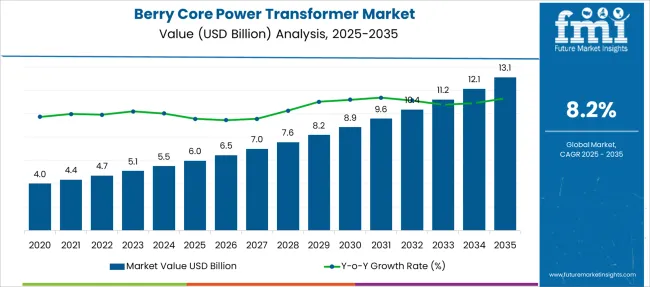
| Metric | Value |
|---|---|
| Berry Core Power Transformer Market Estimated Value in (2025E) | USD 6.0 billion |
| Berry Core Power Transformer Market Forecast Value in (2035F) | USD 13.1 billion |
| Forecast CAGR (2025 to 2035) | 8.2% |
The berry core power transformer market is gaining strong traction due to increasing investments in grid modernization, renewable energy integration, and demand for efficient power transmission solutions. The evolving power infrastructure, particularly in developing regions, is driving the adoption of advanced transformer technologies capable of minimizing core losses and improving operational efficiency. Government initiatives aimed at reducing transmission losses and enhancing energy reliability are further accelerating market penetration.
The unique structural efficiency of Berry core designs has positioned them as a preferred choice in compact, high-capacity installations. With industries and utilities focused on enhancing power quality and system stability, the demand for reliable, high-performance transformers is being elevated.
Future market growth is expected to be shaped by the need for transformers that support digital monitoring, reduced lifecycle costs, and environmentally compliant designs. As the global emphasis on energy efficiency intensifies, Berry Core Power Transformers are projected to remain central to sustainable grid strategies across industrial, utility, and commercial applications.
The market is segmented by Winding, Cooling, Insulation, Mounting, and Application and region. By Winding, the market is divided into Two winding and Auto transformer. In terms of Cooling, the market is classified into Oil immersed and Dry type. Based on Insulation, the market is segmented into Oil, Gas, Solid, Air, and Others. By Mounting, the market is divided into Pad, Pole, and Others. By Application, the market is segmented into Utility, Commercial & Industrial, and Residential. Regionally, the market is classified into North America, Latin America, Western Europe, Eastern Europe, Balkan & Baltic Countries, Russia & Belarus, Central Asia, East Asia, South Asia & Pacific, and the Middle East & Africa.
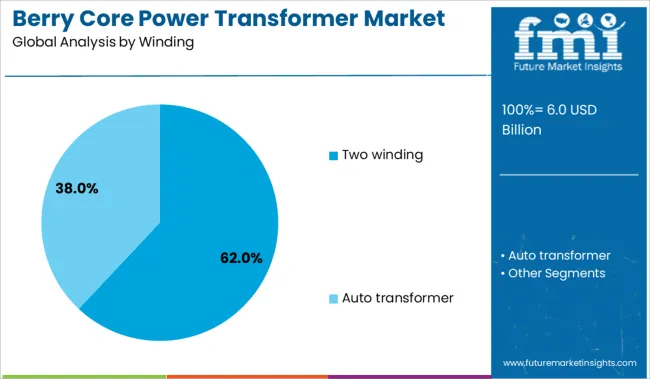
The two winding segment is anticipated to hold 62% of the Berry Core Power Transformer market revenue share in 2025, establishing it as the leading configuration. The segment’s dominance has been attributed to its cost efficiency, simplicity in design, and suitability for a wide range of power applications. Two winding transformers have been widely adopted in power distribution and transmission systems where isolation between circuits is essential for operational safety and reliability.
The segment has benefited from increased deployment in utility grids and industrial setups where stable voltage transformation is required without complex multi-tap features. The inherent mechanical strength and thermal stability offered by Berry core designs have further enhanced the performance of two winding configurations.
In addition, growing demand for standardized solutions with high durability and reduced maintenance requirements has reinforced the adoption of two winding transformers across expanding power networks. As infrastructure upgrades continue globally, the preference for proven and efficient transformer designs is expected to sustain the segment’s leadership.
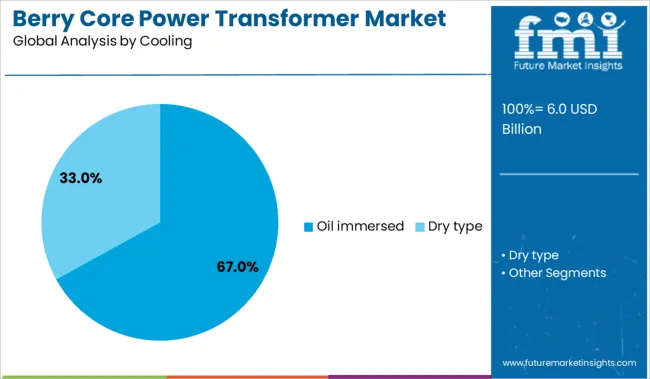
The oil immersed segment is projected to command 67% of the Berry Core Power Transformer market revenue share in 2025, making it the dominant cooling method. This segment has been driven by its high thermal conductivity, superior insulation capabilities, and longer operational lifespan under varying load conditions. Oil immersed cooling has been favored in medium to high voltage applications where consistent temperature regulation and reliability are essential.
The heat dissipation properties of oil cooling systems have supported performance stability, particularly in high-capacity transformer installations. With increasing demand for transformers that can operate continuously under peak loads, the robustness of oil immersed cooling has ensured operational safety and system longevity.
Furthermore, regulatory shifts toward enhanced fire safety and environmental containment have led to improvements in transformer oil formulations, reinforcing user confidence. As power networks expand and the need for thermally efficient systems grows, the oil immersed segment is expected to retain its leading position within the market.
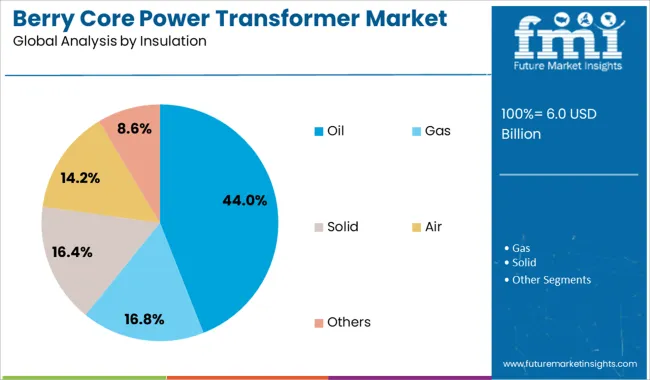
The oil insulation segment is expected to hold 44% of the Berry Core Power Transformer market revenue share in 2025, positioning it as the leading insulation material. The continued reliance on oil-based insulation has been supported by its excellent dielectric strength, cooling properties, and cost effectiveness. Oil insulation has demonstrated strong resistance to electrical and thermal stress, making it a suitable choice for both distribution and power transformers deployed in demanding environments.
This segment has gained further momentum from utility and industrial sectors seeking proven insulation systems that ensure reliable long-term performance. The adoption of oil insulation has also been favored in applications where compact design and high voltage endurance are critical.
Technological advancements in oil purification and monitoring systems have contributed to improved efficiency and maintenance cycles, extending transformer life. As operational resilience and energy efficiency remain high priorities, the use of oil insulation in Berry core transformers is anticipated to continue leading within this segment.
Demand rises due to efficiency needs, grid modernization, and growing renewable power integration. Opportunities exist in utility-sector adoption, oil-immersed transformer growth, and Asia‑Pacific expansion driven by infrastructure upgrades and energy transition.
The market is propelled by the pursuit of reduced power losses and superior load handling. Berry core designs offer lower core losses and improved voltage stability, enhancing overall operational efficiency-appealing to utilities and industrial users. Aging and overloaded grid infrastructure, especially in developed regions, is undergoing modernization, increasing investment in efficient transformers.
Additionally, the growing use of renewable electricity sources-like wind and solar farms situated far from consumption centers-necessitates reliable power transmission and distribution equipment. This further boosts demand for specialized transformer types. Between 2024 and 2032, the market is expected to grow at over 8% CAGR, with utility applications expected to expand at more than 7.5% annually due to these drivers
Major growth opportunities lie in utilities upgrading to oil‑immersed berry core transformers, which deliver better thermal performance and longer life under heavy load-projected to exceed USD 6 billion by 2032. The Asia‑Pacific region, expected to surpass USD 4.5 billion by that year, offers high potential thanks to rapid industrial development, dense infrastructure investments, and energy transition initiatives.
In markets like India and China, rising grid infrastructure spending and smart-grid adoption create fertile ground for deployment. Targeting utility and industrial sectors with tailored cooling options, compact formats, and region-specific support can unlock wider acceptance. Strategic collaborations, localized manufacturing, and financing partnerships further enhance access in emerging economies
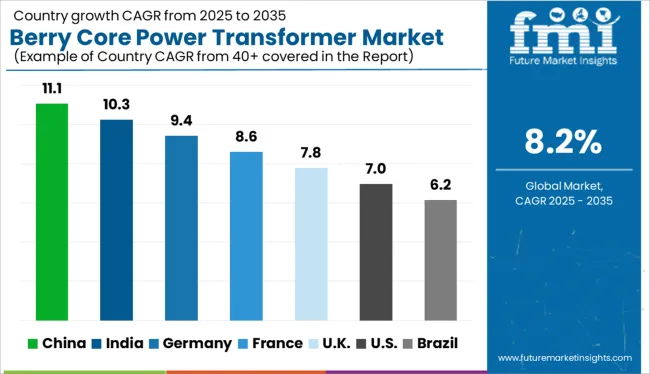
| Countries | CAGR |
|---|---|
| China | 11.1% |
| India | 10.3% |
| Germany | 9.4% |
| France | 8.6% |
| UK | 7.8% |
| USA | 7.0% |
| Brazil | 6.2% |
The global berry core power transformer market is projected to expand at a CAGR of 8.0% from 2025 to 2035, driven by increasing grid modernization, renewable energy integration, and demand for energy-efficient power distribution systems. Among BRICS nations, China leads with an impressive 11.1% CAGR, supported by rapid electrification, infrastructure upgrades, and domestic manufacturing scale.
India follows at 10.3%, fueled by rural electrification programs, power sector reforms, and rising renewable capacity. In the OECD region, Germany is growing at 9.4%, reflecting strong investment in green grids and industrial efficiency.
The United Kingdom (7.8%) shows stable demand through smart grid development and net-zero energy targets, while the United States (7.0%) supports growth via grid hardening initiatives and transformer fleet replacement. This report covers detailed analysis of 40+ countries, and the top five countries have been shared as a reference.
With a CAGR of 11.1%, China leads global growth in the Berry core power transformer segment, powered by national electrification efforts and strong support for energy-efficient grid infrastructure. Widespread deployment across industrial parks, renewable energy hubs, and smart city networks is accelerating transformer upgrades.
Domestic manufacturers are rapidly increasing production of silicon-steel Berry cores, leveraging government subsidies and local demand. High-voltage substation installations across the coastal provinces are creating strong downstream opportunities. Export demand is rising from Southeast Asia and Africa, as Chinese brands gain technological competitiveness and scale advantages in turnkey power projects.
India is projected to grow at a CAGR of 10.3%, spurred by grid modernization programs, rural electrification, and the expansion of metro-rail and renewable energy installations. Demand for high-efficiency Berry core designs is surging, particularly in solar farms, EV charging infrastructure, and smart substations.
Local transformer manufacturers are integrating Berry cores to meet efficiency benchmarks under Bureau of Energy Efficiency (BEE) regulations. State utilities are shifting toward lower loss equipment as part of long-term energy savings targets. As private players expand data centers and industrial power networks, the market is shifting from legacy core models to advanced magnetics-based configurations.
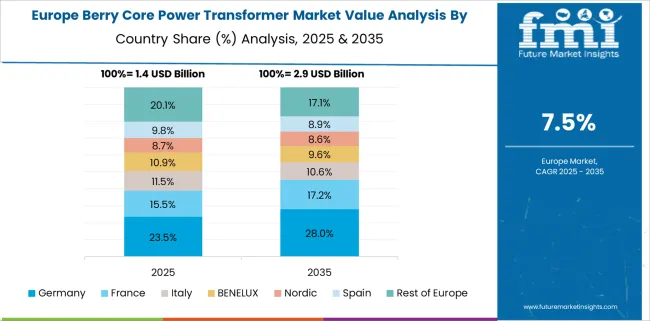
Germany is forecast to expand at a CAGR of 9.4%, driven by aggressive decarbonization goals and grid reinforcement projects tied to wind and solar integration. Transmission and distribution operators are replacing legacy transformers with low-loss Berry core alternatives that improve power density and thermal performance.
Key applications are emerging in offshore wind power, regional substations, and microgrid deployments. Regulatory requirements on energy efficiency and localized power balancing encourage utilities to upgrade infrastructure. Demand from equipment exporters is also on the rise, as German-built transformers increasingly include Berry cores to meet EU eco-design standards.
The Berry core power transformer market in the United Kingdom is expected to grow at a CAGR of 7.8%, fueled by nationwide efforts to improve energy resilience, reduce transmission losses, and prepare grid systems for electrified transport. Electrification of public transit and integration of decentralized energy sources are driving demand for compact, high-efficiency core designs.
The market is witnessing higher tender volumes from utilities shifting toward high-performance distribution transformers. Partnerships between local utilities and global engineering firms are improving supply chain reliability. Advanced monitoring technologies are being bundled with Berry core designs to enable predictive maintenance across critical infrastructure.
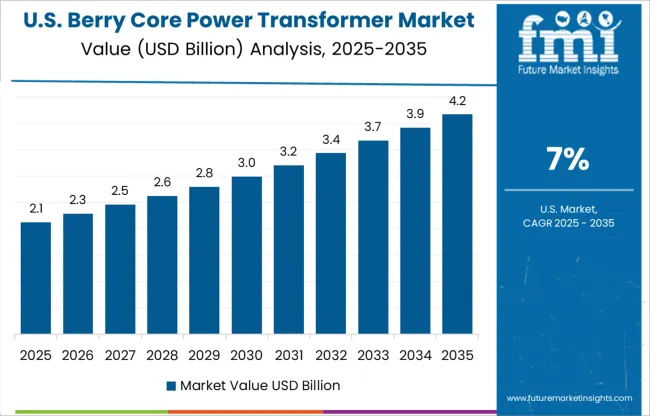
The United States is anticipated to grow at a CAGR of 7.0%, as utilities invest in long-overdue grid upgrades, disaster-proofing measures, and renewable energy distribution. While traditional transformer designs still dominate the base, Berry core configurations are making inroads in energy-intensive sectors such as data centers, EV charging corridors, and commercial complexes.
Manufacturers are responding with domestic assembly capabilities to reduce import dependencies, particularly amid rising material costs. Federal clean energy incentives and infrastructure spending are channeling funds into high-efficiency equipment. Despite relatively slower adoption, technical validations and UL certifications are boosting credibility among commercial buyers.
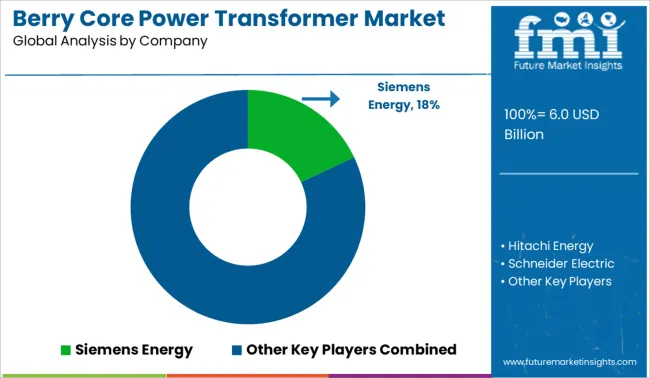
The Berry core power transformer market is moderately consolidated, dominated by a few multinational manufacturers with advanced engineering capabilities and strong utility partnerships. Siemens Energy leads with an 18% market share, leveraging cutting-edge core design technology that improves efficiency, reduces losses, and supports grid reliability in high-load applications.
Tier 1 competitors like Hitachi Energy, Schneider Electric, and Eaton offer energy-efficient, compact transformer systems tailored for smart grid integration, renewable energy support, and urban infrastructure. Tier 2 players such as TBEA and CG Power focus on cost-effective regional solutions and high-capacity transformers for industrial and utility-scale deployments. Market growth is driven by grid modernization, renewable energy integration, and the global push for energy-efficient power transmission infrastructure.
| Item | Value |
|---|---|
| Quantitative Units | USD 6.0 Billion |
| Winding | Two winding and Auto transformer |
| Cooling | Oil immersed and Dry type |
| Insulation | Oil, Gas, Solid, Air, and Others |
| Mounting | Pad, Pole, and Others |
| Application | Utility, Commercial & Industrial, and Residential |
| Regions Covered | North America, Europe, Asia-Pacific, Latin America, Middle East & Africa |
| Country Covered | United States, Canada, Germany, France, United Kingdom, China, Japan, India, Brazil, South Africa |
| Key Companies Profiled | Siemens Energy, Hitachi Energy, Schneider Electric, Eaton, TBEA, CG Power and Industrial Solutions, and Others |
| Additional Attributes | Dollar sales by core type including rectangular, round, and oval berry core designs; voltage class such as low, medium, and high voltage applications; end-user sectors including utilities, industrial plants, and renewable energy installations; regional demand shaped by grid modernization, electrification programs, and industrial expansion; performance factors such as magnetic flux efficiency, low core loss, and compact design; innovation in insulation materials and advanced winding techniques; environmental impact from raw material sourcing and transformer oil disposal; and emerging use cases in compact substations, offshore wind farms, and mobile power systems. |
The global berry core power transformer market is estimated to be valued at USD 6.0 billion in 2025.
The market size for the berry core power transformer market is projected to reach USD 13.1 billion by 2035.
The berry core power transformer market is expected to grow at a 8.2% CAGR between 2025 and 2035.
The key product types in berry core power transformer market are two winding and auto transformer.
In terms of cooling, oil immersed segment to command 67.0% share in the berry core power transformer market in 2025.






Full Research Suite comprises of:
Market outlook & trends analysis
Interviews & case studies
Strategic recommendations
Vendor profiles & capabilities analysis
5-year forecasts
8 regions and 60+ country-level data splits
Market segment data splits
12 months of continuous data updates
DELIVERED AS:
PDF EXCEL ONLINE
Mulberry Market
Blueberry Extract Antioxidants Market Size and Share Forecast Outlook 2025 to 2035
Market Share Insights for Blueberry Ingredient Providers
Acai Berry Extracts Market Analysis - Size and Share Forecast Outlook 2025 to 2035
Acai Berry Market Size, Growth, and Forecast for 2025 to 2035
Strawberry Seed Oil Market Analysis by Application, End-use, Distribution channel and Region Through 2035
Elderberry Supplements Market Analysis by Form, End Use Industry, Distribution Channel and Region Through 2035
Boysenberry Market Size and Share Forecast Outlook 2025 to 2035
Haskap Berry Powder Market Size and Share Forecast Outlook 2025 to 2035
White Mulberry Leaves Extract Market Growth - Product Type & Form Insights
Organic Goji Berry Market
Rubus Idaeus (Raspberry) Seed Oil Market Analysis by Food, Pharmaceuticals and Medical, Personal care and Cosmetics and Others Through 2035
Rubus Idaeus (Raspberry) Seeds Market
Rubus Fructicosus (Blackberry) Seed Market Size and Share Forecast Outlook 2025 to 2035
Core Plate Varnishes Market Size and Share Forecast Outlook 2025 to 2035
Core Drill Automatic Feeding Machine Market
Core Banking Solution Market Report – Growth & Forecast 2017-2027
Air Core Fixed Shunt Reactor Market Size and Share Forecast Outlook 2025 to 2035
Air Core Variable Shunt Reactor Market Size and Share Forecast Outlook 2025 to 2035
Multicore Cables Market

Thank you!
You will receive an email from our Business Development Manager. Please be sure to check your SPAM/JUNK folder too.
Chat With
MaRIA